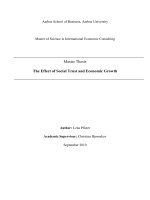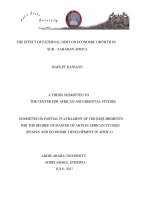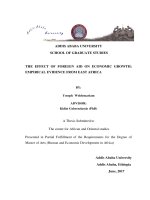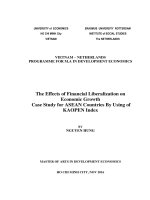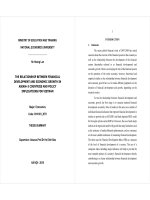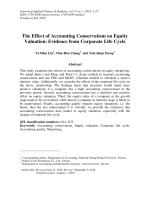The effect of financial development on economic growth evidence from asian countries
Bạn đang xem bản rút gọn của tài liệu. Xem và tải ngay bản đầy đủ của tài liệu tại đây (1.99 MB, 117 trang )
UNIVERSITY OF ECONOMICS
INSTITUTE OF SOCIAL STUDIES
HO CHI MINH CITY
THE HAGUE
VIETNAM
THE NETHERLANDS
VIETNAM - NETHERLANDS
PROGRAMME FOR M.A IN DEVELOPMENT ECONOMICS
THE EFFECT OF FINANCIAL DEVELOPMENT
ON ECONOMIC GROWTH: EVIDENCE FROM
ASIAN COUNTRIES
BY
TRẦN THANH GIANG
MASTER OF ARTS IN DEVELOPMENT ECONOMICS
HO CHI MINH CITY, JULY 2014
UNIVERSITY OF ECONOMICS
INSTITUTE OF SOCIAL STUDIES
HO CHI MINH CITY
THE HAGUE
VIETNAM
THE NETHERLANDS
VIETNAM - NETHERLANDS
PROGRAMME FOR M.A IN DEVELOPMENT ECONOMICS
THE EFFECT OF FINANCIAL DEVELOPMENT
ON ECONOMIC GROWTH: EVIDENCE FROM
ASIAN COUNTRIES
A thesis submitted in partial fulfilment of the requirements for the degree of
MASTER OF ARTS IN DEVELOPMENT ECONOMICS
By
TRẦN THANH GIANG
Academic Supervisor:
ASSOC. PROF. DR. NGUYỄN VĂN NGÃI
HO CHI MINH CITY, JULY 2014
ii
DECLARATION
This is to certify that this thesis entitled “The effect of financial development
on economic growth: evidence from Asian countries”, which is submitted by me in
fulfillment of the requirements for the degree of Master of Art in Development
Economic to the Vietnam – The Netherlands Programme. The thesis constitutes
only my original work and due supervision and acknowledgement have been made
in the text to all materials used.
Trần Thanh Giang
iii
ACKNOWLEGEMENT
I would not be able to write and finish my dissertation without the help and support
of people surrounding me.
Above all, I would like to express my greatest appreciation to my supervisor, Assoc.
Prof. Nguyễn Văn Ngãi, for his invaluable comments and advices, patient guidance,
encouragement in during the time of doing this thesis. I have been strikingly lucky
to have supervisor who cared so much my thesis and answered to all my questions.
Without his guidance, my thesis would not have been possible.
I would also like to offer my special thanks to Dr. Trương Đăng Thụy and Dr. Phạm
Khánh Nam for the econometric guidance and valuable suggestions that help to
develop this thesis.
Besides my mentors, special thanks also to all the lecturers at the Vietnam –
Netherlands Program for their knowledge of all the course, during the time I studied
at the program.
In addition, I would like to thank my friends and people who are always beside me
and support for my thesis but are not above mentioned.
Last, but not least, I am very deeply grateful to my family. Without their warm
encouragement and attention, I would not be possible to complete this dissertation.
iv
ABBREVIATIONS
WB World Bank
OECD Organization for Economic Cooperation and Development
MENA Countries in the Middle East and North Africa
GLS Generalized Least Squares
OLS Ordinary Least Squares
FEM Fix Effects Model
REM Random Effects Model
GMM The Generalized Method of Moments Estimation
v
ABSTRACT
This study estimates the effect of financial development on economic growth in
Asian countries in the period from 2000 to 2011. Based on unbalanced panel data,
this effect is examined by Fixed effects model (FEM) and the first difference
Generalizes Methods of Moments approach (GMM). The findings indicate that
financial development has significant impacts on economic growth on both
estimation techniques. However, these impacts depend significantly on estimation
methods and proxies for financial development. The results of FEM and first
difference GMM imply that financial depth and domestic credit to private sector
have negative impact on growth, but there is no relationship between stock market
development and economic growth. On the other hand, while a positive relationship
between the ratio of commercial – central bank assets and growth rate of real GDP
per capita is shown by FEM, this indicator is not related to growth rates in GMM
results.
Key words: Financial development, Economic growth, relationship, effect,
endogeneity, fixed effects, random effects, Asian countries.
vi
TABLE OF CONTENTS
LIST OF TABLES ..................................................................................................... ix
LIST OF FIGURES .................................................................................................... x
CHAPTER 1: INTRODUCTION ............................................................................... 1
1.1
Problem statements ....................................................................................... 1
1.2 Research objectives ............................................................................................... 4
1.3 Research scope and data ....................................................................................... 4
1.4 Research structure ................................................................................................. 5
CHAPTER 2: LTERATURE REVIEW ..................................................................... 6
2.1 Theoretical literature ............................................................................................. 6
2.1.1 Endogenous growth theory ................................................................................ 6
2.1.2 Theories of financial development ..................................................................... 7
2.2 Empirical studies ................................................................................................. 16
CHAPTER 3: RESEARCH METHODOLOGY ...................................................... 29
3.1 Model Specification ............................................................................................ 29
3.2 Measurements of Variables ................................................................................. 31
3.2.1 Measurements of financial development ......................................................... 31
3.2.2 The determinants of economic growth ............................................................ 34
3.3 Data collection .................................................................................................... 39
3.4 Research methodology ........................................................................................ 39
3.4.1The common constant method (Pooled OLS) ................................................... 40
3.4.2 The random effects method (REM) ................................................................. 41
3.4.3 The Fixed effects method (FEM) ..................................................................... 41
3.4.4 Choice of panel regression model .................................................................... 42
3.4.5 The generalized method of moments estimation (GMM) ................................ 45
vii
CHAPTER 4: RESEARCH RESULTS .................................................................... 48
4.1 Overview the economic growth and the financial development in the regions of
Asia ........................................................................................................................... 48
4.1.1 Overview the economic growth in the regions of Asia in the period 2000 - 2011:
................................................................................................................................... 48
4.1.2 Overview the financial development in the regions of Asia in 2000 - 2011 ... 50
4.2 The descriptive statistic of the sample ................................................................ 57
4.3 Empirical results ................................................................................................. 62
4.3.1 Results of tests for panel regression model ...................................................... 62
4.3.2 Discussions on the research results .................................................................. 65
4.3.3 Discussions on the results of first difference GMM ........................................ 69
CHAPTER 5: CONCLUSION AND POLICY IMPLICATION ............................. 75
5.1 Conclusions ......................................................................................................... 75
5.2 Policy implications .............................................................................................. 77
5.3 Research limitations ............................................................................................ 78
5.4. Suggestions for further research ........................................................................ 79
REFERENCES.......................................................................................................... 81
APPENDIX A ........................................................................................................... 85
APPENDIX B ........................................................................................................... 91
APPENDIX C: DESCRIPTIVE STATISTIC OF VARIABLE ............................... 94
APPENDIX D: PANEL REGRESSION MODEL ................................................... 96
APPENDIX E: RESULTS OF BREUSCH – PAGAN LM TEST ......................... 102
APPENDIX F: RESULTS OF HAUSMAN TEST ................................................ 103
APPENDIX G: THE REGRESSION MODEL RESULTS OF FIRST – DIFFERENCE
GMM ....................................................................................................................... 105
viii
LIST OF TABLES
Table 3.1: The expected sign of variables in model .......................................... 38
Table 3.2: Tests for choosing a panel regression model .................................... 44
Table 4.1 Descriptive statistics of the sample observation ............................... 58
Table 4.2: The corrrelation on the sample observations .................................... 61
Table 4.3: The results of F test and Breusch – Pagan test ................................. 63
Table 4.4: The results of Hausman test ............................................................. 63
Table 4.5: The results of FEM regression model .............................................. 64
Table 4.6: The results of first difference GMM ................................................ 70
ix
LIST OF FIGURES
Figure 2.1: The role of financial development in economic growth ................. 27
Figure 3.1: Analytical framework ..................................................................... 37
Figure 4.1: The average growth rate of real GDP per capita in Asia regions in 2000
– 2011 ................................................................................................................ 50
Figure 4.2: Financial development in Central Asia .......................................... 51
Figure 4.3: Financial development in South - East Asia ................................... 51
Figure 4.4: Financial development in South Asia ............................................. 52
Figure 4.5: Financial development in Eastern Asia .......................................... 53
Figure 4.6: Financial development in Western Asia ......................................... 54
Figure 4.7: The ratio of liquid liabilities to GDP across Asia regions .............. 55
Figure 4.8: The ratio of domestic credit to private sector to GDP across Asia regions
............................................................................................................................ 55
Figure 4.9: The ratio of commercial – central bank assets across Asia regions ....
56
Figure 4.10: The ratio of stock market capitalization to GDP across Asia regions
.......................................................................................................................... 56
Figure 4.11: The scatter diagram among dependent variable and financial
development variables ....................................................................................... 59
Figure 4.12: The scatter diagram among dependent variable and control variables
............................................................................................................................ 60
x
CHAPTER 1: INTRODUCTION
1.1
Problem statements
Contributing to the growth and the process of economic development in a
country requires the combination of related sectors. It has been claimed that finance
is one of the important channels affecting to economic situation. Especially, under
the influences of liberalization and global economic integration, countries are more
concerned with the role of finance. The impact of financial development on
economic growth has been studied in many aspects by many economists since
several decades. Enormous contributions of financial development to the economic
growth were explained by (McKinnon, 1973; Shaw, 1973). As given by (Levine,
1997), financial development is able to improve better investment opportunities,
reduce transaction costs and mobilize savings, hasten technological innovation and
diversify risks for investors. Although there is an argument for the association
between finance and growth, there are many different viewpoints about the
direction of causality. Firstly, finance – led growth hypothesis implies that
economic growth can be promoted by policies focusing on the development of
financial system (King & Levine, 1993b; Levine, Loayza, & Beck, 2000;
McKinnon, 1973). The growth – led finance hypothesis, contrary to the finance –
led growth, suggests that the development of economy will encourage an increase in
demand for the financial services, ultimately financial sector is expanded
(Goldsmith, 1969; Jung, 1986; Shaw, 1973). On the other hand, (Patrick, 1966)
found the bidirectional causality between financial development and economic
growth. The author discovered the causal direction runs from finance to growth in
the early periods of economic growth. Because the provision of financial
instruments, risk management and innovation in technologies can encourage
increasing savings from savers, but at the same time, the investor can achieve higher
level of profits from their investment. It proves that financial development can
1
foster capital accumulation, thus higher economic growth in the first stage of
growth. Obviously, these findings support the finance – led growth hypotheses. In
the later stages, the expansion of financial sector results from increasing demands
for financial services in the growth stage. As a result, it implies a causal direction
runs from growth to finance and it favors the growth – led – finance hypotheses.
However, there is an opinion proposes that financial development is not the most
important factor of growth (Robinson, 1953). In other words, (Lucas Jr, 1988) even
rejected viewpoint that finance plays a major factor of economic growth. Its role has
been over emphasized by economists.
In recent years, many studies have been developed to show the role as well
as the contribution of finance to economic growth in some countries and regions in
the world. However, this relationship is still an ambiguous issue. Besides some
studies also emphasize the positive contributions of financial development to
growth, other investigations provide opposite evidences. For instance, studying 109
developing and industrial countries in 1965 - 1994, (Calderón & Liu, 2003)
suggested that the contribution of financial development to growth is higher in
developing countries than industrial countries. Moreover, this study also supports
for view that financial development can accelerate economic growth through rapid
capital accumulation and technological change. In particular, the causal relation
from finance to TFP growth is stronger in developing countries, but the direction
from TFP growth to finance is stronger in industrial countries. This result is also
similar to capital accumulation. In addition, after combining both cross sectional
and time series data, the result of (Christopoulos & Tsionas, 2004) exhibited that
although there was no bidirectional causality between financial development and
output growth in both long - run and short – run, the positive causality from
financial development to growth was still manifested in 10 developing countries
from 1970 – 2000. (Loayza & Ranciere, 2006), however, suggested that financial
system is able to cause economic recession due to financial crisis. Specifically,
financial development is not always positively related to economic growth. Its
2
effect depends on the characteristic of financial system of each country, institution,
the study period or the measurments of financial development (De Gregorio &
Guidotti, 1995; Hassan, Sanchez, & Yu, 2011; Wu, Hou, & Cheng, 2010).
In general, in spite of the same research subject, it is likely to lead to
different results. In other words, the debatements about the relationship between
financial development and economic growth have been outlined in literatures of
studies by some following reasons. The first controversial issue is the choice of
measurements of financial development because each indicator can lead to various
conclusions. The second aspect is the direction of relationship between these two
issues. While the supply – leading hypothesis, demand – following hypothesis and
two-way causality relationship appear to be supported by some papers, other studies
provide no clear correlation between measures of financial development and
economic growth. The third, the channels through which financial development
impacts economic growth are also disputable issue.
Consequently, finance and economic growth are always an interesting
subject with economists and researchers. If the role of financial development is
clarified, policymakers can outline the judicious development directions and
propose appropriate policies to speed up the national growth.
On the other hand, nowadays, countries not only focus on developing
industrial sector, but they also expand the development of financial sector through
the establishment of financial center, banking system, stock market, etc. Beginning
from the financial crisis in the United State during 2007 – 2009, it has spread to
other countries to create the global crisis. The consequence is the collapse of
financial system in a number of countries and leads to macroeconomic instabilities.
According to the level of financial development and specific characteristics of each
country, the effect of financial crisis on economic growth will be different in those
countries. For this reason, this study is performed to investigate the impact of
financial development on economic growth in Asian countries.
3
1.2 Research objectives
This study aims to:
Analyze the situation of financial development and economic growth in regions of
Asia in the period 2000 – 2011.
Evaluate the impact of financial development on economic growth in Asian
countries.
From the achieved findings, this research will provide some suggestions to promote
the development of financial sector.
1.3 Research scope and data
The research focuses on in Asian countries due to some reasons. First, as
mentioned previously, many studies have examined the effect as well as the
relationship between financial development and economic growth. However,
various conflict findings have been also found different country groups as well as
different periods. In addition, Asian countries, as a whole, have been benefited from
financial liberalization. It yields a more efficient financial system, intensifies the
efficiency and the adjustability of monetary policies.
Thus, Asian countries
succeeded in raising the role of financial system in promoting growth in the period
before 1995. After that, Asian economy went through some large fluctuations
because financial crisis and serious economic recession have consecutively
happened since 2000. Especially, 1997 Asian financial crisis, later on, economic
crisis in 2007 – 2008 caused adverse effects on both financial system and growth in
most Asian countries. For these reasons, this study examines, under such
circumstances, how financial development affects economic growth in Asian
countries in the period 2000 – 2011. From the obtained research findings, we
provide some suggested solutions to overcome several limitations and improve the
contribution of financial sector to the growth.
This study relies on unbalanced panel dataset of 32 countries in 12 years (2000 –
2011). Most data were gathered from the World Development Indicator of World
4
Bank’s database. List of countries is described in detail in the table A.1 (Appendix
A).
1.4 Research structure
The paper contains five chapters:
Chapter 2 introduces theoretical and empirical studies about the role and the
relationship between financial development and economic growth.
Chapter 3 presents regression model and research methodology as well as key
variables used in this study.
Chapter 4 provides an overview about the situation of growth and financial
development in these countries. Moreover, the descriptive statistics of the sample
are also refered in this chapter. Concurrently, analyzing and discussing the
regression results are also mentioned in this part.
Finally, chapter 5 summarizes the analyses and the results from the previous parts to
propose recommendations and related policies as well as the limitations of this
study.
5
CHAPTER 2: LTERATURE REVIEW
This chapter introduces two main parts. The first section provides definitions of
financial development and reviews theoretical backgrounds about the role of
financial development in economic growth. The second section summarizes
previous empirical researches. Based on relevant contents, the final will depict the
construction of conceptual framework for this study.
2.1 Theoretical literature
2.1.1 Endogenous growth theory
Based on the foundations and limitations of neoclassical growth theory,
endogenous growth theory has been developed to clarify the issues of economic
growth as well as the determinants of growth. Neoclassical growth theory assumes
that the growth is due to the improvement of exogenous factors in production
technology, human capital accumulation, population growth and saving rate. These
are exogenous elements for growth. However, endogenous growth theory predicts
that the growth is determined by factors generated in the production process instead
of outside factors. It implies that one or more these elements are defined directly in
the growth model, thus they become endogenous variables. Ak model, which is also
called endogenous growth model, is established from the production function:
Y = AK(HL)1-
(2.1)
A is the production technology. We assume that H = K/L (2.2), which means human
capital and has positive relation with the capital endowment per worker.
Substitution of (2.2) into (2.1) gives a new production function Y = AK. If this new
equation is divided both sides by L, it will give: y = Ak. This production function
indicates that the marginal productivity of capital A does not reduce when the
capital stock increases. In other words, this theory still assumes constant return to
scale, but it does not assume the diminishing returns to scale.
The function y= Ak considers capital as an important input that contributes
directly to the production and increases human capital, thereby output rises linearity
6
with the capital stock. Besides, the Ak model shows that countries with higher
saving rates and investment rates will lead to higher growth rate of per capita. In
addition, higher population growth rates will result in lower income growth per
capita. Unlike neoclassical growth model, endogenous growth model can explain
the growth per capita can continue in countries where do not base on exogenous
technology changes. Furthermore, this theory does not necessarily conclude that the
poor countries will grow faster than rich countries because growth does not
imperatively slow down when income raises. Hence, there is no convergence of
income. Generally, to be similar with Solow growth model, endogenous growth
model also emphasizes the important role of accumulation of production factors as
well as an increase in productivity in the growth process.
2.1.2 Theories of financial development
Financial development is defined as an improvement ịn quality, quantity and
efficiency of financial system. This process involves the combination of many
activities and institutions. According to (Levine, 2005), financial development
happens when financial instruments, markets and intermediaries are improved
better, then they affect the information, enforcement and transaction costs.
Therefore, financial development includes the improvement in allocating resource,
monitoring investment, mobilizing saving, diversifying and managing risk. Besides,
the enhancement in controlling corporate governance after providing finance and
the facilitation in exchanging goods and services are also stimulants to financial
development. Each of these functions is likely to influence saving and investment
decisions, thereby they affects economic growth. In addition, the presence of
financial intermediaries, such as banking system, can make the transmission process
of savings from surplus agents to deficit agents is performed conveniently.
Moreover, the banking sector also helps decrease asymmetric information between
the lender and the borrower as well as allocates funds to the productive
opportunities. The importance of financial intermediaries to economic growth
appears to be supported by (King & Levine, 1993a; Levine et al., 2000; McKinnon,
7
1973; Shaw, 1973). They emphasize that the essential reason for different economic
growth of each country derives from the differences in the quality and quantity of
services provided by financial intermediations. The main roles of financial system
will be discussed in detail in the below part.
2.1.2.1 The role of financial system in the economic growth
The relationship between financial development and economic growth has
been investigated since several decades by many methods and dataset, such as time
series, cross section and panel data. However, researchers have been published
various views and results about this issue. (Goldsmith, 1969; McKinnon, 1973;
Shaw, 1973) who are early researchers point out the finance – growth nexus. Their
papers indicate that financial deepening means not only higher productivity of
capital but also higher saving rate, thus investment is higher. However, (McKinnon,
1973) and (Shaw, 1973) rely on two different models to analyze this issue.
(McKinnon, 1973) considers an outside money model that the company is
constrained to self – finance. Hence, to invest in projects, the firm must accumulate
sufficient savings as monetary assets. Inversely, an inside money model applied by
(Shaw, 1973) emphasizes that real interest rate is main factor to attract savings. As
you know, the credit is influenced by real interest rates. If credit is supplied more,
financial intermediaries can further more investments and higher growth.
Simultaneously, it has been claimed that the difference in growth rate in each
country is due to the differences in the quantity and quality of services provided by
financial intermediations.
In the research model of (Bencivenga & Smith, 1991) represents that
individual must face the choice between either investment in the liquid asset, which
brings safety but low productivity, or illiquid asset, which carries risk but higher
productivity. By enhancing more savings to high productivity and allocating
investment efficiently, financial intermediation can improve economic growth.
Two above researches are evidences supporting the supply - leading
hypothesis (Christopoulos & Tsionas, 2004; King & Levine, 1993b; Levine et al.,
8
2000; McKinnon, 1973). It means that the formation of financial institutions and
financial markets may raise the supply of financial services, thus it leads to
economic growth. In other words, as to this view, there are two channels that
financial intermediation stimulates higher growth. The first channel is an increase in
the efficiency of capital accumulation (Goldsmith, 1969). The other is a rise in
saving rate and investment rate (McKinnon, 1973; Shaw, 1973). Because of an
increase in savings and an improvement in the efficient investments, financial
development results in economic growth. (Bencivenga & Smith, 1991; Greenwood
& Jovanovic, 1989).
The second view is the demand -following hypothesis. This viewpoint is
interpreted that the expansion of financial sector comes from an increase in demand
for financial services (Goldsmith, 1969; Jung, 1986; Shaw, 1973). Because
economic activities raise, demand for both liquid capital and physical capital may
also rise. Eventually, financial sector is expanded. This enlargement contributes to
improving the efficiency and increasing the competition of financial intermediaries
and markets.
The third view is the existence of the bidirectional causality between
financial development and economic growth. This evidence was developed by
(Greenwood & Jovanovic, 1989) who found the positive bidirectional causal
relationship between financial development and growth. The role of financial
institution is collecting and analyzing information to guide investors in higher yield
projects, thus enhancing indirectly the efficiency of investment and growth.
Inversely, the process of growth will also expand financial institution because
higher economic growth will create more demand for transaction and greater
participation in financial market.
The fourth view, contrary to viewpoints above, (Lucas Jr, 1988) claimed that
there is no causal relationship between financial development and economic growth.
Following this view, any policy or strategy stimulating the development of financial
system may produce a waste of resources. Thus, policymakers should be concerned
9
with policies encouraging exports, labour and improving productivity rather than
other factors.
Besides, the bank- based theory mentions a positive role of commercial
banks in economic development because these banks are not prevented by rule of
restrictions. In addition, the bank also mobilizes resources and manages risks
efficiently. The market based theory shows that the markets with high liquidity and
well function can stimulate growth, enhance profit, facilitate to manage and
diversify risks.
Furthermore, the financial services theory combines both the
viewpoint of the bank based and the market based theory. This outlook focuses on
the importance of financial services provided by financial systems. It also means
that financial services are essential condition to expand industrial production and
economic growth.
A number of theoretical models have been investigated to clarify the role of
financial development in economic growth. As given by the neo – classical growth
theory, growth rates of labour force and advances in technology are two important
conditions for economic growth in long – run. As to this theory, to achieve the level
of output growth in short – run, the economy cannot ignore the role of savings.
Hence, the effect of financial intermediation on growth is ambiguously mentioned
through the channel of savings. The introduction of endogenous growth theory
implies that the specific role of financial intermediations in growth is represented by
enhancing Research and Development and investing in human capital. (Pagano,
1993) based on the endogenous growth model to study the impact of financial
development on economic growth. AK model assumes that the production function
is linear and constant returns to scale, but it is not decreasing marginal returns to
scale. Therefore, the output is a function of aggregate capital stock according to the
aggregate production function:
Yt =At*Kt
(2.3)
Return to scale is constant, but the productivity increases owing to the
aggregate capital stock Kt, including the physical and human capital. The model
10
assumes that there is no population growth, and economy only produces one good.
Certainly, those goods can be consumed or invested. In the case of those
commodities are used for purposes of investment, it has the depreciation rate per
period δ. The gross investment is:
It = Kt+1 – (1-δ)Kt.
(2.4)
Based on previous literature, financial institutions are channel through which
savings are transferred to investments. A dollar saved by savers will have worth less
than the value of a dollar for investment. So, θ denotes each dollar saved, and it is
used for investment. (1- θ) is retained by financial institutions. In the close
economy, gross saving equals gross investment: θSt = It
(2.5)
From equation (2.3) we have:
gt+1 = (Yt+1 / Yt ) – 1 = (Kt+1/ Kt ) – 1
(2.6)
Equation (2.4) can be rewritten as: Kt = It + (1 – δ)*Kt+1 , and substitute into
equation (2.6) we have:
gt+1 = ( It + Kt – δKt – Kt )/ Kt = (It/Kt) – δ
(2.7)
From equation (2.3): Kt = Yt/A and combine with equation (2.5), then substitute
into equation (2.7), we set up the following steady state growth rates
g = A*(I/Y) – δ = Aθs – δ
(2.8)
s is gross saving rate (S/Y). From equation (2.8), the development of financial
sector is likely to impact economic growth through three ways. The first one is an
increase in θ that is the proportion of saving channeled to investments. If the
banking sector can be operated in more competitive environment and the transition
from saving to investment is implemented more efficiently, which cause θ can be
increased, thereby growth rate is higher. Secondly, financial institutions, such as the
bank, can increase the productivity of capital (A) by allocating funds to the projects
having the highest margin product of capital and distributing savings more
efficiently. Hence, higher growth results from higher productivity of capital. The
third channel is private saving rates (s).
11
Similarly, in the model of (De Gregorio & Guidotti, 1995), the growth rate of
output yt = stθt is a function of saving rate s and marginal productivity of capital θ.
This function also proves that financial development affects growth through two
channels. The first, the development of domestic financial market may improve the
efficiency of capital accumulation (increasing θ). The second, financial sector
contributes to raising saving rate, thereby higher investment rate (increasing st).
Moreover, the author also supports evidence that the effect of financial development
on economic growth is essential through the efficiency of investment rather than its
volume.
In summary, from studies above demonstrate that the base of economic
growth is the factors of production and the efficient use of those factors.
Another important function of financial system is monitoring managers and
exerting corporate control. Financial arrangements are constructed by the owners of
the firm because these compromises will oblige firm managers operate in the best
interests of the owners. Similarly, banks can also use financial arrangements to
enforce the owners and the managers run enterprises according to the benefits of
banks. On the other hand, outside investors must pay more costs to verify the return
levels of projects because insider investors are likely to distort information about
the project returns to outside investors. These costs, however, can deter investment
decision and decline economic efficiency. Hence, financial contracts that have
lower monitoring and enforcement costs can increase investment efficiency. (Khan,
2001) emphasized the role of external finance channel in the process of economic
growth. Due to the informational asymmetries between borrowers and lenders,
when the producer want to approach loans to invest, the lender must spend more
costs to verify the production capacity and the financial situation of firms.
Therefore, the presence of financial intermediaries may perform debt contracts,
which include costs when borrowers are unlikely to repaid loans. An increase in the
provision of external finance leads to an increase in borrowers’ collateral net worth,
which proves higher firm’s solvency. This issue declines the costs of the contract of
12
finance. Concurrently, a decline in the costs of supplying external finance will
narrow the spread between the borrowing and lending rate. As a result, financial
contracts become more efficiently, which in turn induce higher return on investment
and higher economic growth. In conclude, financial arrangements which reduce
asymmetric information and ameliorate corporate control will better the allocation
of resources. This is foundation to further faster capital accumulation and economic
growth
Besides, to attain more funds for projects, insiders must seek for financing
from many outsiders. Meanwhile, financial intermediaries can mobilize savings
from many individuals, then they lend these resources to the project owners. In this
relationship, both savers and intermediaries can monitor borrowers while savers do
not need to supervise intermediaries because these institutions manage well
diversified portfolio, and they always ensure to pay deposit interest rate on schedule
to depositors. Consequently, due to lower information costs and monitoring costs,
financial intermediaries may improve investment efficiency and better resource
allocation.
On the other hand, the appearance of asymmetric information and transaction
cost will increase liquidity risk. This is foundation leads to the establishment of
markets and financial institutions. Savers do not like risk. As you know, investment
projects which have high returns always accompany with higher risks, while the
projects with lower risk will bring lower yields. Financial market with capacity for
diversifying portfolio will move savers to the projects with higher expected yields.
Thus, by eliminating risk of liquidity, banks can also enhance savings and increase
investment in high return projects and illiquid assets, so they may stimulate the
growth. Therefore, financial intermediaries, such as bank, stock market and fund
provide services of risk diversification. Besides, the well function of risk
diversification not only improves the efficient resource allocation and higher saving,
but also affects capital accumulation and technological innovation.
13
(Saint-Paul, 1992) developed a model to clarify how the financial market
affects the technological choice. The first strategy is high flexibility and allows the
productive diversification but has low productivity. The other strategy is more
productive and more specialize. The financial market helps individuals who hold
diversified portfolio against negative demand shock and choose high productive
technology. Because the individual can be diversified their portfolio via the stock
market, they can reduce risk and increase the proportion of resource allocated to
firm and encourage the specialization of production, thereby economic growth is
higher. Later on, (Levine & Zervos, 1996) concluded that the liquidity of stock
market and the development of banking system correlate positively and
significantly with economic growth, capital accumulation and productivity.
Furthermore, the correlation among financial depth and indicators of growth over
time was found in (King & Levine, 1993a). It means that based on the level of
financial development in this period, economists can forecast economic growth,
physical capital accumulation and economic improvement in the following period.
Especially, (Beck, Levine, & Loayza, 2000) and (Levine, 1997) study not only the
relationship between financial development and economic growth but also the
nexus between finance and sources of growth, such as private saving rates, physical
capital accumulation and total factor productivity. The results prove that higher
financial development leads to higher economic growth and total factor
productivity. Also, better allocation of savings and rapid capital accumulation,
which can be achieved by increasing domestic saving rates and attracting foreign
capital, foster technological innovation. Before that, the importance of financial
development on technological innovation was also mentioned in (King & Levine,
1993b). Following this, financial market can identify and evaluate the potential
innovative projects, thus allocating resources efficiently. Therefore, the nation with
a better function of financial system can conduct a successful innovation. On the
contrary, a decrease in the rate of innovation produced by policies distorting
financial system will decline growth rate. Consequently, as to (Beck et al., 2000;
14
King & Levine, 1993b; Levine, 1997), the innovation is the main channel of
transmission between finance and growth.
In conclusion, as to endogenous growth literature, financial development
heightens economic growth through capital accumulation and technological
innovation.
2.1.2.2 Financial liberalization and repression:
According to the McKinnon – Shaw hypothesis, government restrictions on
the activities of financial system, such as interest rate ceiling and high reserve
requirement, not only obstacle financial deepening but also implies a poor function
financial system. This issue may negatively influence economic growth. It is
generally agreed that the real interest rates can affect economic growth through
investment and saving (McKinnon and Shaw, 1973). As you know, investment has
a negative relationship with real interest rates, thus the investment curve is
downward sloping. Conversely, saving curve is upward sloping because saving is a
positive function of real interest rates. Therefore, low real interest rates discourage
savings; so, lower savings will reduce the loanable funds for investment. Lower
investment results in lower economic growth. In other hands, higher interest rates
will encourage savings and reduce investments of entrepreneurs in low return
projects. On the contrary, lower interest rates strengthen the investment into projects
having high - expected return. As a result, the investment efficiency will increase.
As to this school, if the financial repression is removed or financial system is
liberalized more, financial sector can stimulate saving and investment, ultimately
economic growth is higher.
Moreover, the endogenous growth theory appears to favor financial
liberalization. (King & Levine, 1993b), for example, argued that the government
intervention on financial system, such as financial repression, can negatively
influence on financial development and economic growth.
Similarly, (Pagano,
1993) also mentioned that interest rate controls and reserve requirement can affect
the financial intermediary activities.
15
